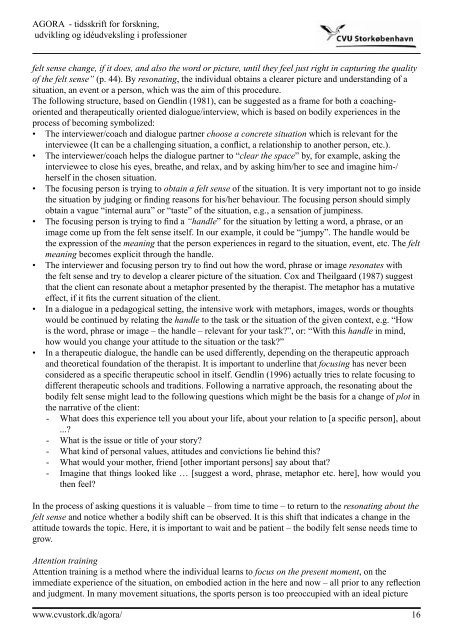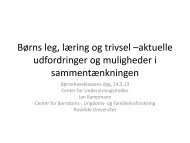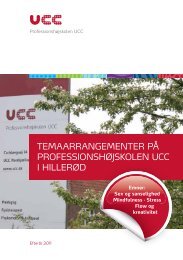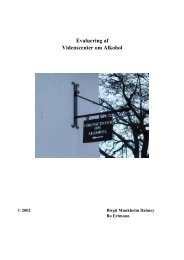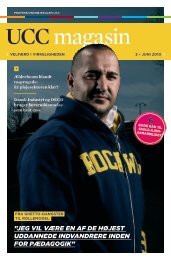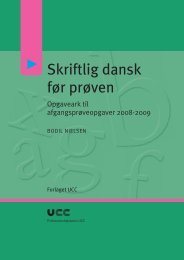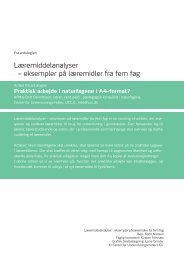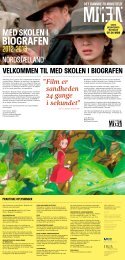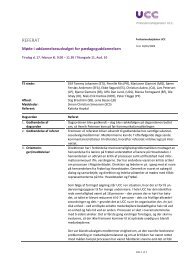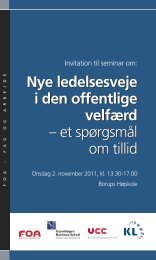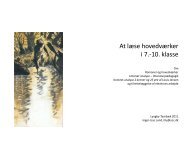AGORA - tidsskrift for forskning, udvikling og idéudveksling i ...
AGORA - tidsskrift for forskning, udvikling og idéudveksling i ...
AGORA - tidsskrift for forskning, udvikling og idéudveksling i ...
You also want an ePaper? Increase the reach of your titles
YUMPU automatically turns print PDFs into web optimized ePapers that Google loves.
<strong>AGORA</strong> - <strong>tidsskrift</strong> <strong>for</strong> <strong>for</strong>skning,<br />
<strong>udvikling</strong> <strong>og</strong> <strong>idéudveksling</strong> i professioner<br />
felt sense change, if it does, and also the word or picture, until they feel just right in capturing the quality<br />
of the felt sense” (p. 44). By resonating, the individual obtains a clearer picture and understanding of a<br />
situation, an event or a person, which was the aim of this procedure.<br />
The following structure, based on Gendlin (1981), can be suggested as a frame <strong>for</strong> both a coachingoriented<br />
and therapeutically oriented dial<strong>og</strong>ue/interview, which is based on bodily experiences in the<br />
process of becoming symbolized:<br />
• The interviewer/coach and dial<strong>og</strong>ue partner choose a concrete situation which is relevant <strong>for</strong> the<br />
interviewee (It can be a challenging situation, a conflict, a relationship to another person, etc.).<br />
• The interviewer/coach helps the dial<strong>og</strong>ue partner to “clear the space” by, <strong>for</strong> example, asking the<br />
interviewee to close his eyes, breathe, and relax, and by asking him/her to see and imagine him-/<br />
herself in the chosen situation.<br />
• The focusing person is trying to obtain a felt sense of the situation. It is very important not to go inside<br />
the situation by judging or finding reasons <strong>for</strong> his/her behaviour. The focusing person should simply<br />
obtain a vague “internal aura” or “taste” of the situation, e.g., a sensation of jumpiness.<br />
• The focusing person is trying to find a “handle” <strong>for</strong> the situation by letting a word, a phrase, or an<br />
image come up from the felt sense itself. In our example, it could be “jumpy”. The handle would be<br />
the expression of the meaning that the person experiences in regard to the situation, event, etc. The felt<br />
meaning becomes explicit through the handle.<br />
• The interviewer and focusing person try to find out how the word, phrase or image resonates with<br />
the felt sense and try to develop a clearer picture of the situation. Cox and Theilgaard (1987) suggest<br />
that the client can resonate about a metaphor presented by the therapist. The metaphor has a mutative<br />
effect, if it fits the current situation of the client.<br />
• In a dial<strong>og</strong>ue in a pedag<strong>og</strong>ical setting, the intensive work with metaphors, images, words or thoughts<br />
would be continued by relating the handle to the task or the situation of the given context, e.g. “How<br />
is the word, phrase or image – the handle – relevant <strong>for</strong> your task?”, or: “With this handle in mind,<br />
how would you change your attitude to the situation or the task?”<br />
• In a therapeutic dial<strong>og</strong>ue, the handle can be used differently, depending on the therapeutic approach<br />
and theoretical foundation of the therapist. It is important to underline that focusing has never been<br />
considered as a specific therapeutic school in itself. Gendlin (1996) actually tries to relate focusing to<br />
different therapeutic schools and traditions. Following a narrative approach, the resonating about the<br />
bodily felt sense might lead to the following questions which might be the basis <strong>for</strong> a change of plot in<br />
the narrative of the client:<br />
- What does this experience tell you about your life, about your relation to [a specific person], about<br />
...?<br />
- What is the issue or title of your story?<br />
- What kind of personal values, attitudes and convictions lie behind this?<br />
- What would your mother, friend [other important persons] say about that?<br />
- Imagine that things looked like … [suggest a word, phrase, metaphor etc. here], how would you<br />
then feel?<br />
In the process of asking questions it is valuable – from time to time – to return to the resonating about the<br />
felt sense and notice whether a bodily shift can be observed. It is this shift that indicates a change in the<br />
attitude towards the topic. Here, it is important to wait and be patient – the bodily felt sense needs time to<br />
grow.<br />
Attention training<br />
Attention training is a method where the individual learns to focus on the present moment, on the<br />
immediate experience of the situation, on embodied action in the here and now – all prior to any reflection<br />
and judgment. In many movement situations, the sports person is too preoccupied with an ideal picture<br />
www.cvustork.dk/agora/ 16


